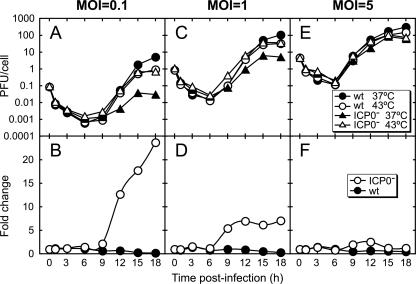FIG. 4.
Cellular heat shock enhances the replication efficiency of an ICP0− virus in an MOI-dependent manner. Twenty-four-hour-old Vero cell monolayers were infected at MOIs of 0.1, 1, and 5 PFU/cell of wild-type (KOS) or ICP0− (n212) virus. Viral titers for wild-type and ICP0− viruses were determined on Vero and L7 cells, respectively. Infected cells were incubated at 37°C and harvested at 3-h intervals. Virus titers were determined by standard plaque assay, with wild-type virus titrated on Vero cells and ICP0− virus titrated on ICP0-expressing L7 cells. The titers of the inocula were also determined by standard plaque assay and are represented as the 0-h time points. The top row (A, C, and E) represents viral yields, and the bottom row (B, D, and F) represents the change (n-fold) in replication efficiency following heat shock, calculated by dividing the number of PFU/cell following heat shock by the number of PFU/cell without heat shock. The figure is representative of two experiments which produced similar results.

